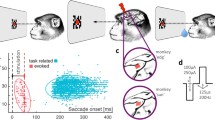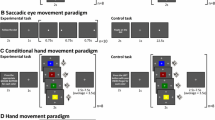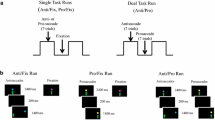Abstract
This experiment sought to find whether differences exist between the dorsolateral prefrontal cortex (DLPFC) and the medial rostral prefrontal cortex (MRPFC) for performing stimulus-independent and stimulus-oriented tasks, respectively. To find a causal relationship in these areas, we employed the use of trans-cranial magnetic stimulation (TMS). Prefrontal areas were stimulated whilst participants performed random or predictable sequence learning tasks at stimulus onset (1st presentation of the sequence only for both Random and Predictable), or during the inter-sequence interval. Overall, we found that during the predictable task a significant decrease in saccade latency, gain and duration was found when compared to the randomised conditions, as expected and observed previously. However, TMS stimulation in DLPFC during the delay in the predictive sequence learning task reduced this predictive ability by delaying the saccadic onset and generating abnormal reductions in saccadic gains during prediction. In contrast, we found that stimulation during a delay in MRPFC reversed the normal effects on peak velocity of the task with the predictive task revealing higher peak velocity than the randomised task. These findings provide causal evidence for independent functions of DLPFC and MRPFC in performing stimulus-independent processing during sequence learning in saccades.




Similar content being viewed by others
References
Alvarez TL, Alkan Y, Gohel S, Douglas Ward B, Biswal BB (2010) Functional anatomy of predictive vergence and saccade eye movements in humans: a functional MRI investigation. Vision Res 50(21):2163–2175. doi:10.1016/j.visres.2010.08.018
Bahill AT, Clark MR, Stark L (1975) The main sequence a tool for studying human eye movements. Math Biosci 24(3–4):191–204
Basso D, Ferrari M, Palladino P (2010) Prospective memory and working memory: asymmetrical effects during frontal lobe TMS stimulation. Neuropsychologia 48:3282–3290
Becker W, Fuchs AF (1969) Further properties of the human saccadic system: eye movements and correction saccades with and without visual fixation points. Vis Res 9:1247–1258
Boorman ED, Behrens TE, Woolrich MW, Rushworth MF (2009) How green is the grass on the other side? Frontopolar cortex and the evidence in favour of alternative courses of action. Neuron 62:733–743
Bosch SE, Neggers SF, Van der Stigchel S (2013) The role of the frontal eye fields in oculomotor competition: image-guided TMS enhances contralateral target selection. Cereb Cortex 23(4):824–832. doi:10.1093/cercor/bhs075
Burgess PW, Scott SK, Frith CD (2003) The role of the rostral frontal cortex area (area 10) in prospective memory: a lateral versus medial dissociation. Neuropsychologia 41:906–918
Burgess PW, Dumontheil I, Gilbert SJ (2007) The gateway hypothesis of rostral prefrontal cortex (area 10) function. Trends Cogn Neurosci 11(7):290–298
Burke MR, Barnes GR (2008) Brain and behaviour: a task dependent eye movement study. Cereb Cortex 18(1):126–135
Burke MR, Bramley P, Gonzalez CC, McKeefry D (2013) The contribution of the human right supra-marginal gyrus to sequence learning in saccadic eye movements. Neuropsychologia 51(14):3048–3056
Coubard O, Kapoula Z (2005) Dorsolateral prefrontal cortex prevents short-latency saccade and vergence: a TMS study. Cereb Cortex 16(3):425–436
Coubard O, Kapoula Z, Müri R, Rivaud-Péchoux S (2003) Effects of TMS over the right prefrontal cortex on latency of saccades and convergence. IOVS 44(2):600–609
Gilbert SJ, Spengler S, Simons JS, Steele JD, Lawrie SM, Frith CD, Burgess PW (2006) Functional specialization within rostral prefrontal cortex (area 10): a meta-analysis. J Cogn Neurosci 18:932–948
Hassabis D, Kumaran D, Maguire EA (2007) Using imagination to understand the neural basis of episodic memory. J Neurosci 27:14365–14374
Henson DB (1979) Investigation into corrective saccadic eye movements for refixation amplitudes of 10 degrees and below. Vis Res 19:57–61
Herwig U, Satrapi P, Schonfeldt-Lecuona C (2003) Using the international 10-20 EEG system for positioning of trans-cranial magnetic stimulation. Brain Topogr 16:95–99
Koechlin E, Summerfield C (2007) An information theoretical approach to prefrontal executive function. Trends Cogn Neurosci 11(6):229–235
Koval MJ, Lomber SG, Everling S (2011) Prefrontal cortex deactivation in macaques alters activity in the superior colliculus and impairs voluntary control of saccades. J Neurosci 31(23):8659–8668
Martin K, van Donkelaar P (2012) Expectations can modulate the frequency and timing of multiple saccades: a TMS study. Exp Brain Res 221:3146
Mason MF, Norton MI, Van Horn JD, Wegner DM, Grafton ST, Macrae CM (2007) Wandering minds: the default network and stimulus independent thought. Science 315:393–395
McKeefry DJ, Burton MP, Vakrou C, Barrett BT, Morland A (2008) Induced deficits in speed perception by transcranial magnetic stimulation of human cortical areas V5/MT+ and V3A. J Neurosci 28:6848–6857
Müri RM, Rivaud S, Vermersch AI, Leger JM, Pierrot-Diesilligny C (1996) Effects of transcranial magnetic stimulation over the region of the supplementary motor area during sequences of memory guided-saccades. Exp Brain Res 104:163–166
Müri RM, Gaymard B, Rivaud S, Vermersch A, Hess CW, Pierrot-Deseilligny C (2000) Hemispheric asymmetry in cortical control of memory-guided saccades. A transcranial magnetic stimulation study. Neuropsychologia 38(8):1105–1111
Nagel M, Sprenger A, Lencer R, Kömpf D, Siebner H, Heide W (2008) Distributed representations of the “preparatory set” in the frontal oculomotor system: a TMS study. BMC Neurosci 9:89
Owen AM, McMillan KM, Laird AR, Bullmore E (2005) N-back working memory paradigm: a meta-analysis of normative functional neuroimaging studies. Hum Brain Mapp 25(1):46–59
Pascual-Leone A, Wassermann EM, Grafman J, Hallet M (1996) The role of the dorsolateral prefrontal cortex in implicit procedural learning. Exp Brain Res 107:479–485
Pierrot-Diesilligny C, Rivaud S, Gaymard B, Agid Y (1991) Cortical control of reflexive visually guided saccades. Brain 114:1473–1485
Pierrot-Diesilligny C, Müri RM, Ploner CJ (2003) Decisional role of the dorsolateral prefrontal cortex in ocular motor behaviour. Brain 126:1460–1473
Pierrot-Diesilligny C, Milea D, Müri RM (2004) Eye movement control by the cerebral cortex. Curr Opin Neurol 17:17–25
Raichle ME, Snyder AZ (2007) A default mode of brain function: a brief history of an evolving idea. Neuroimage 37:1083–1090
Schluter ND, Rushworth MF, Passingham RE, Mills KR (1998) Temporary interference in human lateral premotor cortex suggests dominance for the selection of movements. A study using transcranial magnetic stimulation. Brain 121:785–799
Stewart LM, Walsh V, Rothwell JC (2001) Motor and phosphene thresholds: a transcranial magnetic stimulation correlation study. Neuropsychologia 39(4):415–419
Wager TD, Smith EE (2003) Neuroimaging studies of working memory: a meta-analysis. Cogn Affect Behav Neurosci 3(4):255–274
Author information
Authors and Affiliations
Corresponding author
Rights and permissions
About this article
Cite this article
Burke, M.R., Coats, R.O. Dissociation of the rostral and dorsolateral prefrontal cortex during sequence learning in saccades: a TMS investigation. Exp Brain Res 234, 597–604 (2016). https://doi.org/10.1007/s00221-015-4495-2
Received:
Accepted:
Published:
Issue Date:
DOI: https://doi.org/10.1007/s00221-015-4495-2




